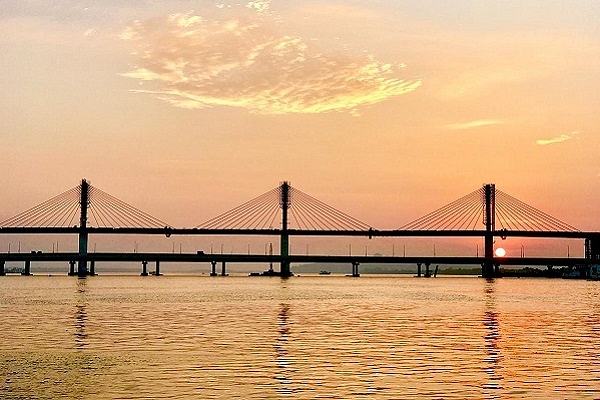
Watch: Modern Goa’s Landmark Third Mandovi Bridge Built In Record 3 Years, To Open On 29 January
The much-awaited third cable-stayed bridge, constructed across river Mandovi at Panaji in Goa will be inaugurated by Union Minister for Road Transport and Highways Nitin Gadkari on 27 January, Navhind Times has reported.
It will be thrown open for the public on 29 January.
A dream project of Goa Chief Minister Manohar Parrikar, he has been personally supervising the construction despite his frail health.
The total length of the cable-stayed Mandovi bridge is 4.2 km and it is 21 metre wide.
Constructed by Larsen and Toubro (L&T) the bridge boasts of a four-lane 900 metre long span with a 620 metre cable stay portion and a 3.3 km viaduct approach. The cost of the project is estimated to be Rs 500 crore approximately. The bridge connects Panaji and Porvorim, in Goa. It carries the National Highway 17 over the tidal part of the Mandovi River.
Project highlights
• Cable Stayed Bridge with length of 620 metre and width of 21 metre
• Viaduct with length of 3330 metre and width of 19.20 metre
• Pile Foundation – Diameter of Piles : 1500 mm f 1200 mm
• Solid approaches having length of 504 metre
• Lane Configuration : 4 lanes
• Navigational Span : 150 metre
• Height of 4 Pylons from bridge deck : 30 metre
• Height of 4 Pylons from High Flood Level : 73.50 metre
Here are some of the images of the bridge’s construction:
Once the bridge is open, the vehicles proceeding from both Margao and Mapusa would be able to use it.
The main bridge superstructure consists of a 21 metre wide externally strutted segmental concrete box girder with dual carriageway of 2 x 8.5 metre with 3 metre wide median at the centre.
The box girder will be supported by stay cables which will be anchored in the pylon and stressed from box girder bottom. Another flyover originating from the Merces-Old Goa bypass road will join the Mandovi bridge for traffic from Ponda to go towards Margao.
According to GSIDC (Goa State Infrastructure Development Corporation Limited) vice-chairman Sidharth Kuncalienker, the bridge is fully designed by engineers from L&T, Indian Engineers, GSIDC, TPF and IIT-Chennai.
He was quoted as saying that “Except the bridge cables, everything else that has gone into the making of the bridge is Indian. In fact, many components have been made in Goa, The cables were imported as they are not available in India”.
Kuncalienker also said that the Goa State Infrastructure Development Corporation (GSIDC) has saved almost 10 crore litre treated water while constructing the third Mandovi bridge by using curing compound, instead of water.
The construction of the third bridge was legally challenged by a group of NGOs who claimed that it was carried out without the requisite environment clearance. They also alleged some 247 mangrove trees were destroyed while constructing ramps to access the bridge.
The first Mandovi bridge was built in the 1971 and it collapsed in 1986. A second bridge was built in 1998. The first and second bridge were both multiple span beam bridges.